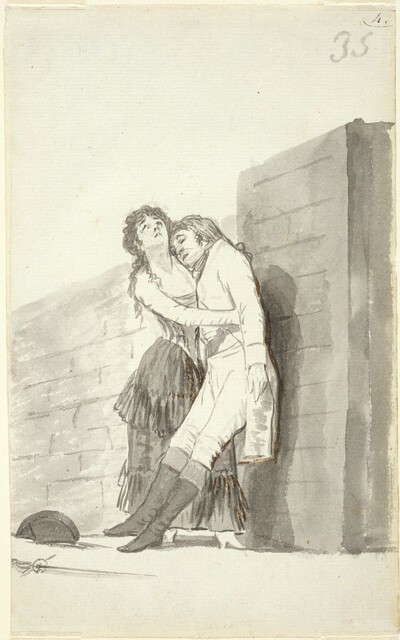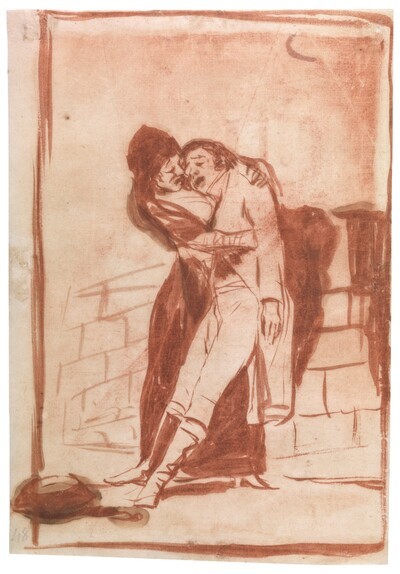- Cronología
- Ca. 1797 - 1799
- Dimensiones
- 219 x 152 mm
- Técnica y soporte
- Aguafuerte, aguatinta bruñida y buril
- Reconocimiento de la autoría de Goya
- Undisputed work
- Ficha: realización/revisión
- 30 Jul 2013 / 29 May 2024
- Inventario
- 225
El amor y la muerte. (at the bottom)
10. (in the upper right-hand corner)
See Francisco de Goya y Lucientes, Painter.
There is a proof of state prior to the letter deposited in the British Museum and from the Enriqueta Harris Frankfort collection, which has the title in manuscript with good calligraphy. There is also another proof in the Bibliothèque Nationale de France in Paris with the same legend smudged.
Engraving no. 10, Love and Death, was preceded by two preparatory drawings in the Prado Museum (1) and (2) . Drawing no. 35 in Album B or Album of Madrid should also be considered the germ of this print.
A woman holds in her arms a man who appears to have been wounded in a duel, as the sword lying at his feet testifies. There is an expression of anguish and pain on his face, perhaps because he has been mortally wounded. The woman's face also hints at suffering, with her mouth half-open and her eyes closed. The scene takes place in an open space and the man's body is leaning against a low wall.
The Aragonese painter used aquatint to create the background, with a lighter area at the bottom and a darker area at the top, which could be a device that heralds the dawn. As in many other engravings in this series, he has left a lighter surface to attract the viewer's attention; in this case the white garments of the dying figure capture our interest.
The Ayala manuscript notes of this print: "It is not convenient to draw the sword many times: love exposes to quarrels and challenges". In the Prado's Museum it is stated that "Here is a lover of Calderón who for not knowing how to laugh at his competitor dies in the arms of his beloved and loses because of his recklessness. It is not convenient to draw the sword too often". Finally, it is worth mentioning what the manuscript in the Biblioteca Nacional comments on this engraving: "From illicit loves, nothing but noise and quarrels usually follow".
This print has been the subject of various interpretations. The most widespread of these, which is based both on the image and on the three manuscripts referred to above, is that this scene is a criticism of the duels. We should also consider Juliet Wilson-Bareau's reading of this work based on a comparison of the print with drawing no. 35 of the Madrid Album or Album B, Young Woman Holding Her Dying Lover. The woman in the drawing is looking up at the sky, so it seems that rather than showing grief she is expressing exasperation. The sword lying on the ground and the limp posture of the man in the print lead one to identify his death with the "death" of the passion of an old man unable to satisfy the desires of a young woman. This idea is reinforced by the way Goya has depicted the face of the man in the print as older than the figure in the drawing. If so, this print would continue the theme of the previous print in the Caprices series, No. 9, Tantalus.
The plate is in poor condition ( National Chalcography, no. 181).
-
Goya. Gemälde Zeichnungen. Graphik. TapisserienKunsthalle BaselBasle1953from January 23th to April 12th 1953cat. 202
-
Goya. Das Zeitalter der Revolucionen. Kunst um 1800 (1980 – 1981)Hamburger KunsthalleHamburg1980cat. 269
-
Goya dans les collections suissesFundación Pierre GianaddaMartigny1982consultant editor Pierre Gassier. From June 12th to August 29th 1982cat. 45
-
Goya. La década de Los CaprichosMadrid1992organized by Real Academia de Bellas Artes de San Fernando sponsored by Fundación Central Hispano, Madrid, consultant editor Nigel Glendinnig. From October 26th 1992 to January 10th 1993cat. 20
-
Francisco de GoyaMuseo d'Arte ModernaLugano1996exhibition celebrated from September 22nd to November 17th.cat. 10, p.37
-
Francisco Goya. Sein leben im spiegel der graphik. Fuendetodos 1746-1828 Bordeaux. 1746-1996Galerie KornfeldBern1996from November 21st 1996 to January 1997cat. 16
-
Das Capriccio als KunstprinzipWallraf-Richartz-Museum,1996from December 8th 1996 to February 16th 1997, exhibited also in Zurich, Kunsthaus, from March 14th marzo 1997 to June 1st 1997 and in Vienna, Kunsthistorisches Museum mi Palais Harrach, from June 29th 1997 to September 21st 1997.cat. G. 37
-
Francisco Goya. Capricci, follie e disastri della guerraSan Donato Milanese2000Opere grafiche della Fondazione Antonio Mazzottacat. 10, p.19
-
Goya e la tradizione italianaFondazione Magnani RoccaMamiano di Traversetolo (Parma)2006consultant editors Fred Licht and Simona Tosini Pizzetti. From September 9th to December 3th 2006cat. 10, p.148
-
Goya. Opera graficaPinacoteca del Castello di San GiorgioLegnano2006exhibition celebrated from December 16th 2006 to April 1st 2007p.24
-
Goya et la modernitéPinacothèque de ParisParís2013from October 11st 2013 to March 16th 2014cat. 133
-
Goya: Order and disorderMuseum of Fine ArtsBoston2014cat. 72
-
2022
-
Goya engravings and lithographs, vol. I y II.OxfordBruno Cassirer1964p.80, cat. 45
-
Vie et ouvre de Francisco de GoyaParísOffice du livre1970p.177, cat. 469
-
Goya, la década de los caprichos: dibujos y aguafuertesMadridReal Academia de Bellas Artes de San Fernando1992pp.33-36, cat. 20-21
-
Catálogo de las estampas de Goya en la Biblioteca NacionalMadridMinisterio de Educación y Cultura, Biblioteca Nacional1996p.79, cat. 98
-
El libro de los caprichos: dos siglos de interpretaciones (1799-1999). Catálogo de los dibujos, pruebas de estado, láminas de cobre y estampas de la primera ediciónMadridMuseo Nacional del Prado1999pp.96-99
-
Goya: Order & DisorderBostonMuseum of Fine Arts Boston Publications2014p. 139
-
ParísPinacoteca de París2013p. 194
-
Goya. In the Norton Simon MuseumPasadenaNorton Simon Museum2016pp. 42-75
-
Museo de Bellas Artes de Badajoz y Diputación de Badajoz2022p. 32



